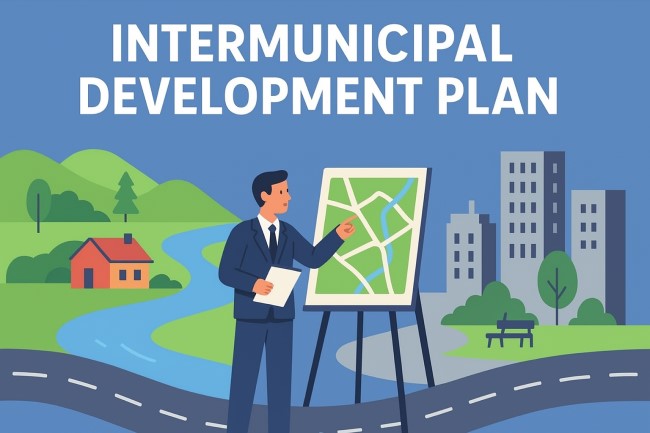Intermunicipal Development Plan: A Comprehensive Guide to Collaborative Municipal Growth

An Intermunicipal Development Plan (IDP) is a strategic tool used by neighboring municipalities to work together in shaping land use, growth, and development policies. It serves as a formal agreement that outlines how adjoining municipalities will manage shared borders, coordinate infrastructure, and address future growth challenges. In many regions, such as under the Municipal Government Act in Canada, these plans are mandatory, ensuring municipalities take a cooperative approach instead of competing for development opportunities.
This guide provides a detailed understanding of what an Intermunicipal Development Plan is, why it is important, how it works, and what benefits it brings to communities.
Understanding an Intermunicipal Development Plan
An Intermunicipal Development Plan is essentially a collaboration framework between two or more municipalities. It sets the rules and guidelines for:
-
Land use and zoning in boundary areas.
-
Coordination of infrastructure and transportation projects.
-
Environmental and resource management.
-
Conflict resolution in planning matters.
The plan is usually adopted through bylaws by each participating municipality, giving it a strong legal standing.
Key Objectives of an IDP
An IDP is designed to achieve multiple strategic goals:
-
Coordinated Land Use Planning – Prevents conflicting development at municipal borders.
-
Infrastructure Efficiency – Enables shared roads, utilities, and public services.
-
Environmental Protection – Safeguards water sources, natural habitats, and green spaces.
-
Economic Development – Attracts investment through stable and predictable policies.
-
Conflict Prevention – Establishes clear communication channels and dispute resolution methods.
Why an Intermunicipal Development Plan Matters
When municipalities grow independently without coordination, problems often arise, including:
-
Overlapping infrastructure investments leading to wasted resources.
-
Conflicting land uses, such as industrial areas built next to residential neighborhoods.
-
Environmental degradation due to inconsistent conservation policies.
-
Inefficient service delivery because of duplicated facilities.
An IDP addresses these issues by ensuring municipalities plan together for mutual benefit.
Legal Requirement in Some Jurisdictions
In certain regions, an Intermunicipal Development Plan is not optional. For example, under specific municipal laws, all municipalities that share a common boundary must develop and adopt an IDP. This legal requirement ensures that urban and rural areas work together to manage shared challenges and opportunities.
Components of an Intermunicipal Development Plan
A strong IDP typically contains the following sections:
1. Introduction and Purpose
This section outlines the reason for the plan, the municipalities involved, and the mutual benefits of collaboration.
2. Goals and Principles
It establishes guiding principles such as sustainability, economic growth, and environmental stewardship.
3. Land Use Policies
The plan specifies how land will be used in the shared areas, including:
-
Residential zones.
-
Commercial and industrial districts.
-
Agricultural preservation zones.
-
Parks and natural reserves.
4. Infrastructure and Transportation Planning
This section addresses shared roads, transit systems, utility networks, and public facilities.
5. Environmental Management
Policies for protecting rivers, forests, wetlands, and wildlife corridors are detailed here.
6. Dispute Resolution Mechanisms
The plan outlines how disagreements between municipalities will be resolved without harming long-term relationships.
7. Review and Amendment Process
An IDP is not a static document; it must be reviewed regularly and updated to reflect changing circumstances.
Benefits of an Intermunicipal Development Plan
Implementing an IDP offers significant advantages to all parties involved.
Improved Regional Cooperation
By creating a shared vision, municipalities can build stronger working relationships and reduce political tensions.
Better Service Delivery
Joint planning enables cost-sharing for essential services like waste management, fire protection, and recreation facilities.
Economic Growth
A unified development approach makes the region more attractive to investors who value stability and clear regulations.
Efficient Use of Taxpayer Money
When municipalities pool resources for infrastructure projects, costs are reduced, and projects are completed faster.
Environmental Protection
Shared environmental policies ensure that ecosystems and natural resources are protected across borders.
Challenges in Developing an IDP
While beneficial, the process of creating an Intermunicipal Development Plan can face challenges:
-
Political Differences – Municipalities may have different priorities and visions for growth.
-
Funding Disagreements – Sharing costs fairly can be complex.
-
Public Resistance – Residents may fear changes in land use or governance.
-
Legal Complexity – Drafting a plan that complies with multiple municipal regulations can be time-consuming.
Overcoming these challenges requires open communication, public engagement, and a willingness to compromise.
Steps to Develop an Intermunicipal Development Plan
The process generally follows these stages:
Step 1: Establish Partnership
Neighboring municipalities agree to work together and define the scope of the IDP.
Step 2: Gather Data and Analyze
Planners collect information on population growth, land use, infrastructure, and environmental assets.
Step 3: Public Consultation
Residents, business owners, and community organizations are invited to share their views.
Step 4: Draft the Plan
Policies, maps, and strategies are developed collaboratively.
Step 5: Formal Adoption
Each municipality passes the IDP through a bylaw, making it legally binding.
Step 6: Implementation and Review
The plan is put into action and periodically reviewed for updates.
Real-World Example
Consider two municipalities that share a river boundary. Without an IDP, one side could approve heavy industrial development, while the other promotes tourism and recreation. The result would be conflicting uses and potential environmental harm. With an IDP, both sides can agree on zoning that balances economic growth with environmental preservation, ensuring both communities benefit.
Conclusion
An Intermunicipal Development Plan is far more than just a legal requirement—it is a proactive approach to sustainable growth, economic stability, and environmental protection. By fostering collaboration between neighboring municipalities, IDPs create stronger, more resilient regions that can adapt to change while preserving their unique character.
Municipal leaders, planners, and residents all have a role in ensuring that the principles outlined in an IDP are followed. With clear communication, mutual respect, and a shared vision, intermunicipal cooperation can become one of the most powerful tools for regional success.



